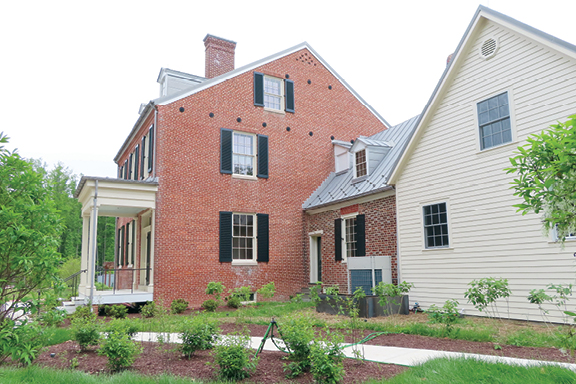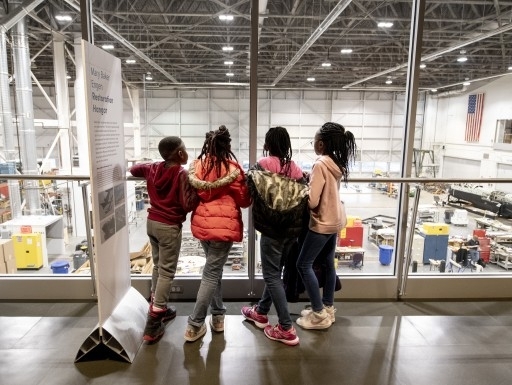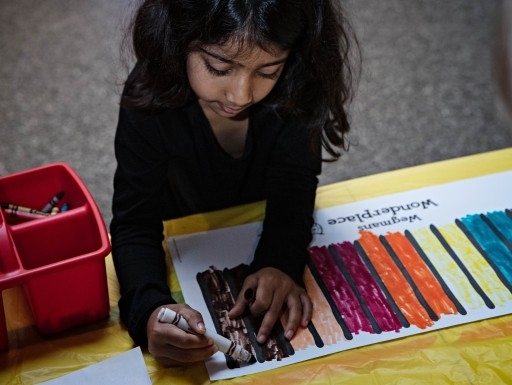
Woodlawn House today consists of three sections: the original 1735 kitchen at center, the three-story 1841 brick edifice at left, and a 1970s wing at right.
PHOTO Christine Dunham/SERC

Woodlawn’s citizen scientists range from high school students to retirees.
PHOTO Stephen Voss

A 17th century tobacco pipe bowl reflects Native American design.
PHOTO (pipe bowl) James Gibb, (background) Stephen Voss
Ten years ago, when Smithsonian Environmental Research Center (SERC) archaeologist James Gibb and his team began excavating the grounds of Woodlawn House—the oldest building in the Smithsonian’s collection still on its original site—it didn’t take long for history to announce itself.
The team soon discovered the remains of a “summer kitchen” dating to the late 1700s, located about 100 feet from the original house, built in 1735. “The shovel went into the ground, there was a ‘clank,’ and we knew we hit brick,” Gibb recalled. “No one knew the kitchen was there.”
Woodlawn House overlooks rolling farmland on the research center’s 2,650-acre campus in Edgewater, Md., near the Chesapeake Bay. It has many stories to tell—about American history and how humans impact the land over time—but, until this summer, few of those stories had been presented to the general public.
That will change June 29 when Woodlawn House opens to visitors for the first time. Its new incarnation will include a new SERC welcome center and a permanent exhibition, Woodlawn History Center, which traces the history of the house and surrounding land from Native American settlement to today.
The exhibition was co-created by Woodlawn’s unique team of all-volunteer citizen scientists, who conduct the site’s long-running archaeological study. They range from high school students to retirees, and their research has been key to understanding the life of the house.
Woodlawn House was built in 1735 for tobacco planter William Sellman and his family. They were among the first European families to settle in Maryland, and their descendants lived in the house until around 1910. The Kirkpatrick-Howat family then occupied the house through 2010, when the Smithsonian acquired the building.
In addition to the two families, enslaved African Americans, servants and tenant farmers lived in and around the house. Little is known about the enslaved residents; the SERC team is working with a local African American historian and genealogist to research this group.
“This one small place has many important connections to the American story, from colonial times through slavery, the American Revolution, Jim Crow and beyond,” said SERC program manager and exhibition curator Christine Dunham. “We also focus on environmental history: Native use of the land and the colonists’ impact on the land, up through the last owners of the house, who planted an arboretum on the lawn.”
One of the more interesting artifacts discovered by the archaeological team ties early colonial agriculture to commerce. A small tobacco pipe bowl, dating to the 1650s-1670s, features stick figures of deer that reflect Native American design, together with a bowl shape that reflects European design. The hybrid was likely a Native product made for European consumers.
As Woodlawn House begins its next chapter, it will bring more stories like this to life—weaving history, archaeology and the environment together in surprising ways.
Descendants of the Sellman and Kirkpatrick-Howat families provided support for Woodlawn House’s exhibition.
They include Betsy Kirkpatrick-Howat, Stephen and Eva DeVience, Sally Sellman and Bob Gombar, and Bernard and Jean Sellman Graf.
Published June 2022 in IMPACT Vol. 8 No. 2
Your gift fuels innovation, inspiration and exploration for lifelong learners everywhere. Make a gift today.



